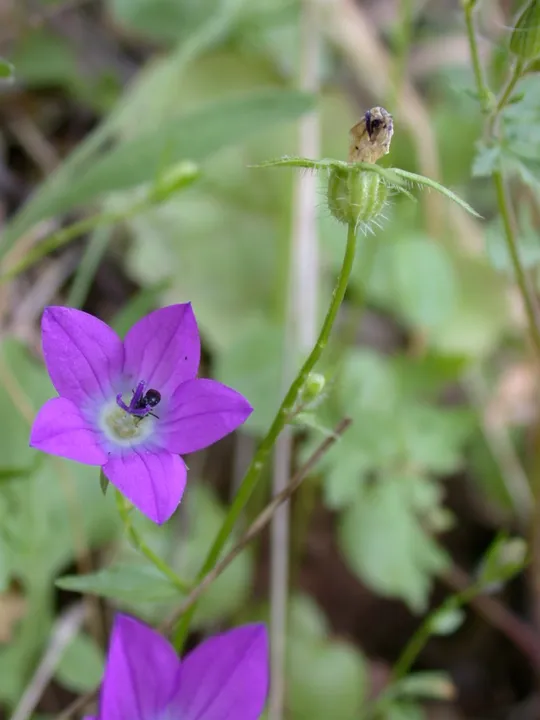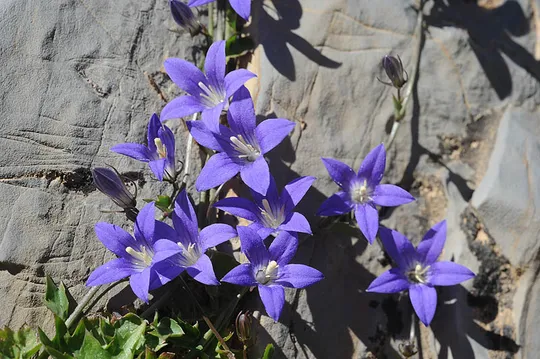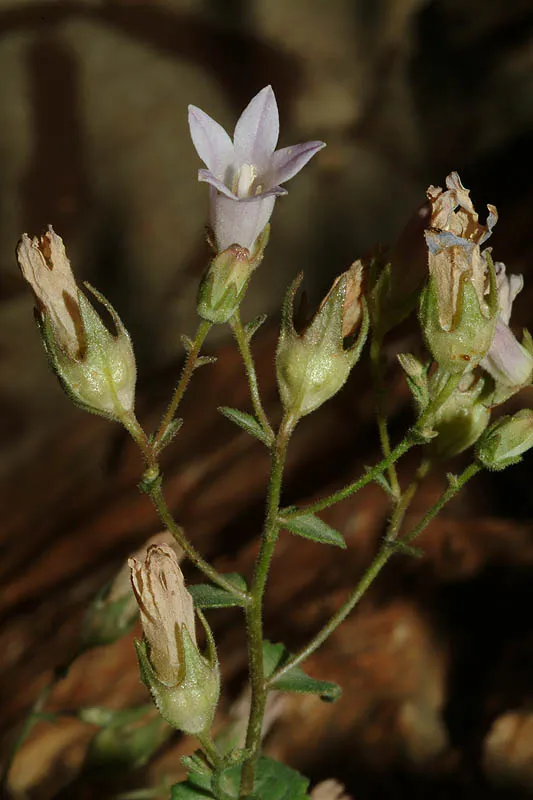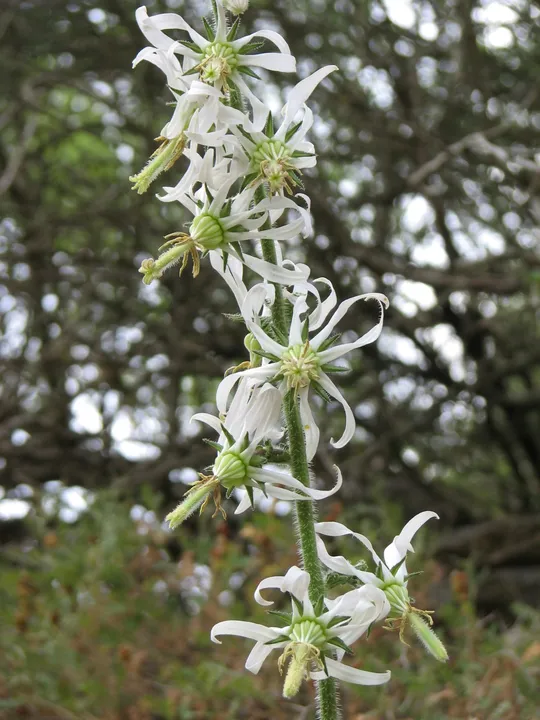Peregrinating Bellflower, Foreign Bellflower
Campanula peregrina
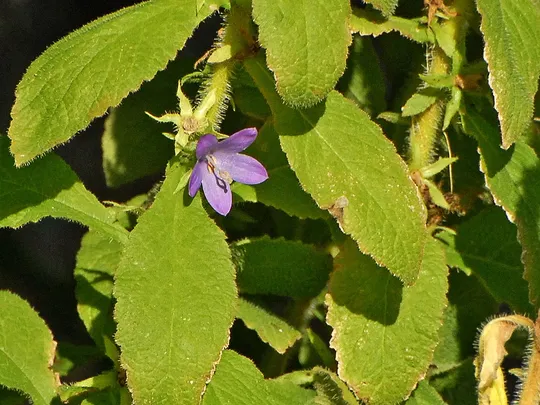
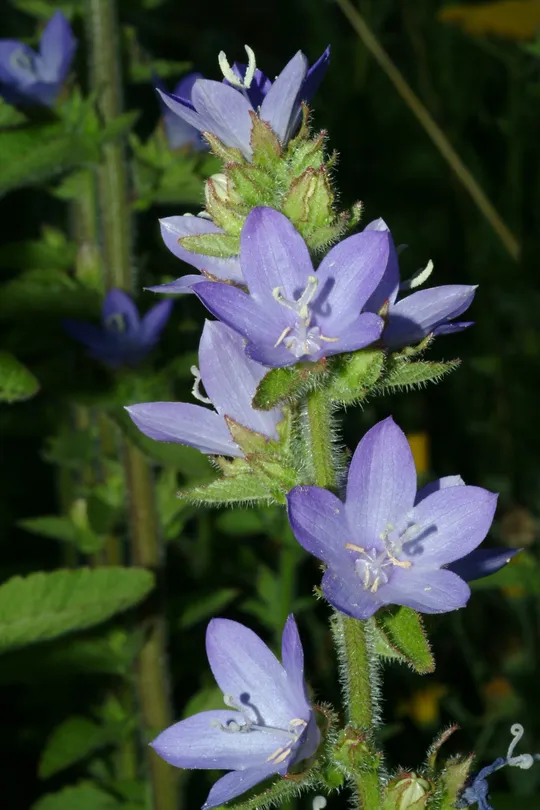
The specific epithet of Campanula
peregrina means "foreigner, wanderer" and was given in
the
scientific description of the species by Linnaeus. He was
mistaken and at the time of description of the species believed that the
species was foreign to the European flora and grew at the Cape of Good Hope.
The species description in Hebrew notes its large and opulent flowers, compared
to other species growing in Israel.
The plant is recommended for gardening. Beautiful
flowering plants from seeds collected in the Kziv Stream can be seen in the
Jerusalem Botanical Gardens.
In Israel Campanula peregrina
grows only in the Upper Galilee, at a single site at the Kziv Stream near En
Tamir, where Amitai Aharoni found it in 1984 and identified as a new species for
Israel (Schmida, 1985). It disappeared for a few years after flooding and digging
by boars, although a few isolated specimens have been observed again in recent
years. The Nature and Parks Authority reinforced the only wild population with
plants grown from local seeds in the Givat Ram Botanical Garden.
In Israel – streambeds, near running water shaded by woodland.
In the Kziv Stream, it grows in a thicket of Rubus sanguineus and Melissa
officinalis. In the world – along flowing channels, moist locations,
springs, and muddy sites. It is characteristic of the rivers flowing in western
Lebanon.
The genus Campanula consists of about 300
species, mostly herbaceous annuals or perennials. A few species are dwarf
shrubs or climbers. The genus range extends throughout the Northern Hemisphere,
particularly in the Mediterranean area and the Caucasus Mountains and in
tropical regions. Many species are rock and cliff plants. Twelve species grow in
Israel, mostly annuals.
C. peregrina belongs to an
Eastern Mediterranean distribution group that includes Turkey, Syria, Lebanon,
Cyprus and Israel. In Turkey, the species is limited only to its southern-Mediterranean
part at altitude of 270-1220 meters. In Cyprus, C. peregrina
is noted as "locally-limited" at an attitude of 0-1500 meters. There it
usually grows near streams at high altitudes, but occasionally also on moist
soils at low altitudes. In Syria and particularly in Lebanon, C. peregrina
grows in most of the streams flowing into the Mediterranean Sea. It is quite
common in the Chouf Mountains in Lebanon and was observed in 1982 the shade of
forests and near running water, at an altitude of 1000-1200 meters. The Kziv
Stream site is the southern distribution limit of the species in the world.
·
Campanula peregrina grows in a
single region in a unique and rare habitat, the banks of constantly flowing mountain
streams. The site is an extreme southern point of its global distribution.
·
C. peregrina grows as
individual plants scattered in the field, occasionally as an isolated plant.
The seeds are small and numerous and are dispersed by the strongly shaking the
plant, but there is a lack of information regarding their viability and
germination rates in nature. The lifespan of each plant is not known with
certainty; it is probably a short-lived perennial and may be monocarpic (blooms
and produces fruit only once and then dies). It is easy to successfully culture
from seeds.
·
Extreme flow regime changes in the Kziv
Stream may lead to the extinction of C. peregrina. It is also threatened by picking
because of its attractiveness and the prominence of its flowers, although its
site is far from inhabited areas and not easily accessible.
·
C. peregrine is protected in
the Kziv Stream Nature Reserve.
·
The plant grows throughout the Eastern
Mediterranean Basin and is not globally endangered.
The Kziv Stream
should be surveyed again in detail in the month of July to obtain an updated
assessment of the number of plants in nature and their location. Subsequently, the
species should be monitored and studied. Individual plants should be marked, to
study their lifespan, obtain basic demographic data and to understand the
possible reasons for the fluctuations in its population size. It is important
to maintain a stable water flow in the Kziv Stream. The ongoing activity
developing backup populations in botanical gardens and refuge gardens should be
continued.
Eastern Mediterranean. Campanula
peregrina grows in Rhodes, Southern Turkey, Cyprus, on the
western slopes of the mountains of Syria and Lebanon and at a single site in
the Upper Galilee.
Campanula peregrina is a short lived
perennial herbaceous species that grows at a single site in Israel on the banks
of the Kziv Stream, which constitutes the extreme southern limit of its global
distribution. It is endangered by its great rarity, its attractiveness for picking
and changes in its water flow regime.
שמידע, א. 1985. שירת העשבים - צמחי החודש. טבע וארץ כ"ח/1.
Current Occupancy Map
| 1000 squre meter pixel | 5000 squre meter pixel | 10000 squre meter pixel | |
|---|---|---|---|
| number of observations | 0 | 0 | 0 |
| in total pixels | 0 | 0 | 0 |
| Family | Campanulaceae |
| Classification | On the endangered species list |
| Ecosystem | Mediterranean humid |
| Chorotype | Eastern Mediterranean |
| Conservation Site | En Tamir on Kziv Stream |
| Rarity |
1
6
6
|
|---|---|
| Vulnerability |
0
0
4
|
| Attractiveness |
0
2
4
|
| Endemism |
0
0
4
|
| Red number |
1
4.7
10
|
| Peripherality | N |
| IUCN category | DD EW EX LC CR EN VU NT |
| Threat Definition according to the red book | Endangered |
 Based on:
Based on:
